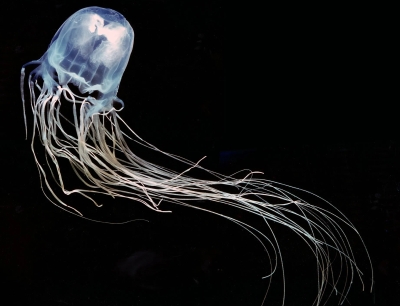 
The Box jellyfish is the most toxic animal on earth, with venom containing toxins that attack the heart, nervous system, and skin. It can be found in the coastal waters off northern Australia. They are distinguished by their box-like body. Some species of box jellyfish produce potent venom delivered by contact with their tentacles. Stings from some species are extremely painful and often fatal to humans. Box jellyfish can move more rapidly than other jellyfish; speeds of up to 2 metres per second have been recorded. Depending on the species, a fully grown box jellyfish can have a body length of up to 20 cm, and the tentacles can grow up to 3 m long. Its weight can reach 2 kg. There are about 15 tentacles on each corner of its box-like body. Each tentacle has about 500,000 cnidocytes, containing nematocysts, harpoon-shaped microscopic mechanisms that inject venom into its victim. The thumbnail-sized Irukandji box jellyfish is also lethal despite its small size. The box jellyfish actively hunts its prey, small fish, rather than drifting as do true jellyfish. While some species of box jellyfish have been called "the world's most venomous creature" only a few species have been confirmed to be involved in human deaths; some species are not harmful to humans, delivering a sting that is just painful. In Australia, fatalities are most often caused by the largest species of this jellyfish, Chironex fleckeri, which is certainly one of the world's most venomous creatures. After severe Chironex fleckeri stings, cardiac arrest can occur quickly, within just two minutes. In Australia, Chironex fleckeri has caused at least 79 deaths since the first report in 1883, but most encounters appear to result only in mild symptoms. The most recent deaths in Australia have been in children. |